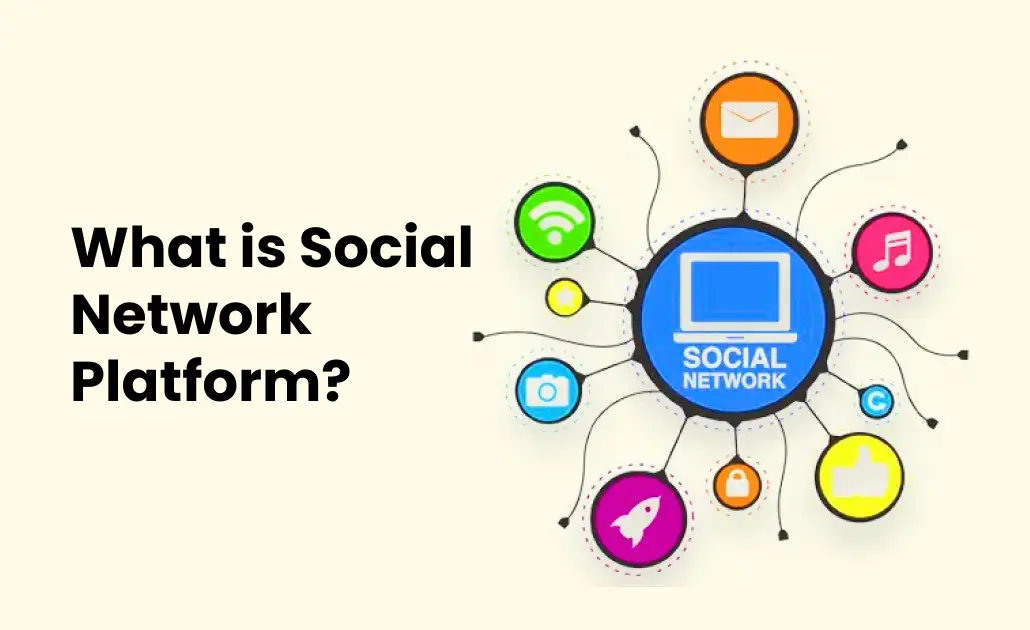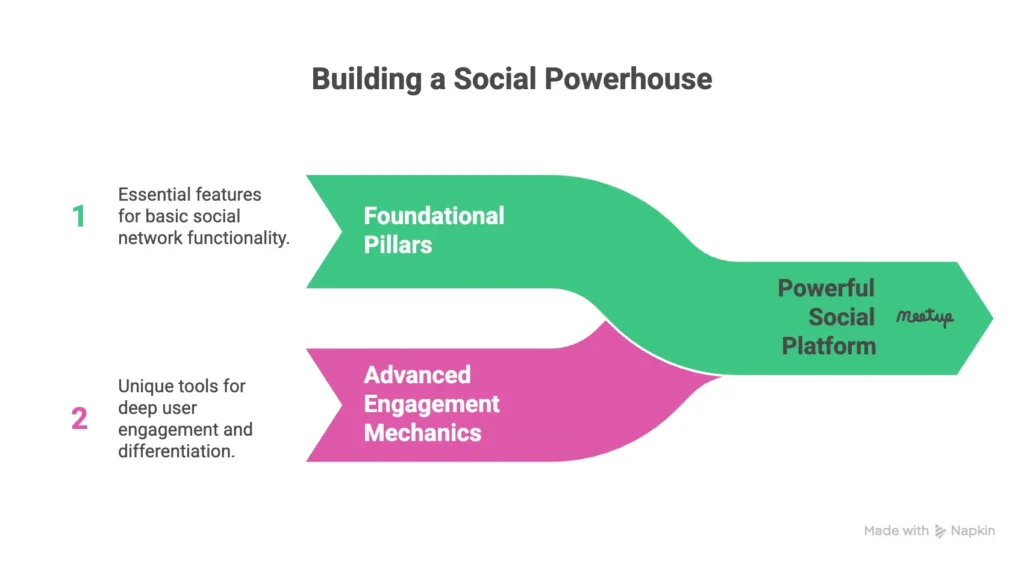What Is a Social Network Platform? Why Your Business Needs One

As entrepreneurs and business leaders, we’ve all been told to “build a community.” For years, that meant creating a Facebook Group or a LinkedIn page, gathering followers, and posting content. We played by the rules of the big platforms, chasing algorithm changes and fighting for visibility in a noisy, crowded space. But what if that whole approach is built on a flawed premise? What if you’re building your brand’s most valuable asset—its community—on rented land?
I learned this firsthand. As a tech founder, I spent countless hours building and scaling a self-hosted social network using Laravel. The experience taught me a crucial lesson that has nothing to do with code and everything to do with strategy. A social network isn’t just a feed of content; it’s an owned asset. It’s the digital equivalent of moving from renting an apartment to owning the entire building. This post is for the new entrepreneur, the business person who wants to understand what a social network platform really is, and why owning yours is one of the most powerful strategic moves you can make.
Back to Basics: Deconstructing the Social Network Platform
Before we dive into strategy, let’s get our definitions straight. The term “social network platform” is often misunderstood, leading to costly mistakes. It’s not just a place to post updates; it’s a foundational piece of business infrastructure.
More Than Just Software: It’s Re-brandable, Pre-built Community Infrastructure
At its core, a white label social network is a customizable, pre-built software platform that allows you to launch your own fully branded online community without developing the core infrastructure from scratch. Think of it as a ready-made framework equipped with all the standard features you’d expect—user profiles, activity feeds, messaging, and groups—that you can then tailor to your brand’s look and feel. The entire purpose is to create a private, exclusive, and controlled digital space where you, not a third-party platform, set the rules.
The “Build vs. Buy vs. License” Decision for Entrepreneurs
The old way of thinking presented a binary choice: build your own software from scratch or buy an off-the-shelf solution. But the modern digital economy, particularly the Software-as-a-Service (SaaS) model, has introduced a powerful third option: “license and brand.” This hybrid approach democratizes access to sophisticated technology. It allows businesses to deploy powerful, brand-aligned software without the massive capital expense and long development timelines associated with building from the ground up. You get the benefits of an owned platform without the prohibitive risk.
A Critical Distinction: Owned Communities vs. Social Media Management Tools
Here’s a crucial pitfall for new buyers. The term “white label social media” can refer to two very different things:
- White Label Social Network Platform: This is software for building an owned community. The end result is a standalone website or mobile app that your business controls. The goal is to cultivate deep, long-term relationships in a private ecosystem.
- White Label Social Media Management Tools: This is software used by marketing agencies to manage their clients’ activities on public social platforms like Facebook and X. The core function is operational efficiency, not building a new, private community.
Mistaking one for the other is a fatal error. One is about owning your building; the other is about redecorating your rented apartment. This guide is exclusively about the former.
The Anatomy of a Powerful Social Platform: Core Features and Beyond

Not all platforms are created equal. A robust white label solution is built on a foundation of essential features but differentiated by advanced mechanics that drive deep engagement.
The Foundational Pillars (The “Table Stakes”)
These are the non-negotiable, bedrock functionalities of any social network. Their absence is a deal-breaker.
- User Profiles & Identity: The cornerstone of community. Members need a space to create their identity with avatars, bios, and custom fields relevant to your community’s purpose.
- Activity Feeds: The “pulse” of the community, providing a real-time stream of posts, comments, and interactions to keep members engaged.
- Content Creation & Sharing: Robust tools for users to communicate by sharing text, images, videos, and links are essential.
- Interaction Mechanics: The core social actions that foster conversation, including comments, likes/reactions, and @mentions.
- Groups & Sub-communities: The ability to create smaller, focused groups around specific topics or projects is critical for preventing overwhelm and facilitating niche conversations.
- Messaging: Private one-on-one and group messaging for direct communication and collaboration.
Where the Magic Happens: Advanced Engagement Mechanics
This is where leading platforms separate themselves, offering tools that create unique value you can’t replicate on public social media.
- Live Streaming & Real-Time Events: Host live webinars, Q&A sessions, or workshops directly within the community to create a sense of immediacy and shared experience.
- Gamification: Incentivize participation by awarding points, badges, and leaderboards to foster friendly competition and reward engagement.
- Event Management: Go beyond live streams with comprehensive tools for organizing both online and offline events, including RSVPs, ticketing, and attendee communication.
- Specialized Functionality: This is the evolution toward “Community-as-a-Service.” Many platforms now integrate value-added modules like Learning Management Systems (LMS) for online courses, e-commerce storefronts, and job boards, turning the community into a multi-purpose business hub.
Making It Yours: The Brand Customization Suite
The core promise of “white label” is infusing the platform with your brand identity.
- Visual Identity Control: Comprehensive tools to customize logos, color palettes, fonts, and layouts for a seamless brand experience.
- Branded Mobile Apps: A key differentiator is the ability to launch a fully branded native app on the Apple App Store and Google Play Store, putting your brand on your users’ home screens.
- Custom Domain & Email: Host the community on a custom domain (e.g.,
community.yourbrand.com) and send all notifications from your brand’s email address to completely mask the provider.
The Strategic “Why”: Unlocking Business Value with an Owned Platform
Choosing a white label solution isn’t a tech decision; it’s a business strategy. It’s about taking control of your audience, your data, and your destiny.
From Renter to Owner: The Power of an Immersive Brand Ecosystem
On public social media, your brand is perpetually a guest, competing with ads, algorithm changes, and endless distractions. An owned platform creates a focused, distraction-free environment. The conversation is centered exclusively on your brand and the shared interests of your community, leading to higher-quality engagement.
More importantly, it provides data sovereignty. When you build a community on a public platform, you are sacrificing data for reach. You don’t own the user data; the platform does. With a white label solution, you retain 100% ownership of all user data and content. This first-party data is a strategic goldmine, offering unfiltered insights into customer behavior, preferences, and pain points that can inform product development and marketing strategy.
The Founder’s Perspective: Time, Money, and Speed-to-Market
Building a platform from scratch is a massive undertaking. Custom development can cost hundreds of thousands of dollars and take a year or more to launch. A white label solution slashes this time-to-market to weeks, allowing you to build momentum almost immediately. This is the competitive advantage.
This is where my own experience comes in. When I launched my Laravel-based network, the tech was solid—but growth came from targeting niche groups and partnering with micro-influencers, not just the code. Using a pre-built framework (even one I built myself to be reusable) freed up my most valuable resources—time and focus—to work on what actually moves the needle: community building, content strategy, and user engagement. I wasn’t bogged down in endless development cycles; I was out there building the business.
From Cost Center to Profit Center: Mastering Monetization
An owned platform gives you the tools to turn your community into a direct profit center. You can implement diverse and controllable revenue streams, such as:
- Tiered membership plans with recurring subscriptions.
- Selling access to exclusive online courses or paid virtual events.
- Integrated e-commerce for physical merchandise.
Crucially, you typically retain 100% of the revenue. There is no platform “tax” or revenue share, ensuring the full value you create flows directly to your business.
Choosing Your Path: A Comparative Framework for Entrepreneur
The right path depends on your resources, goals, and priorities. Here’s a breakdown of the three main options.
White Label vs. Custom Build vs. Public Groups
- White Label Platform: The balanced, accelerated approach. It offers the best combination of branding, control, and speed for most businesses.
- Custom-Built Platform: The path of ultimate control, but at a very high cost in time and money. Best for companies with truly unique needs and deep pockets.
- Public Social Media Groups: The “rented land” option. It’s free and easy to start but offers minimal control, no data ownership, and high strategic risk due to algorithm and policy changes.
Strategic Comparison of Community Platform Options
This table breaks down the trade-offs across key business criteria.
| What You’re Comparing | ShaunSocial (Self-Hosted) | Scrile Connect (SaaS) | Fanso (Self-Hosted) | Appkodes Fundoo |
|---|---|---|---|---|
| Up-front price | $79 license + $400 mobile add-on | Monthly subscription | $499 + paid add-ons | ~$1,000 one-time |
| Source code access | ✅ Yes | ❌ No | ✅ Yes | ✅ Yes |
| High-risk payment gateway | DIY integration | ✅ Included | Stripe/PayPal only | Vague promise |
| Automated commission split | Manual (for now) | ✅ Yes | Paid add-on | ✅ Yes |
| Live-streaming | Via Agora.io add-on | Built-in WebRTC | Add-on | Built-in |
| Time to launch | 4–12 weeks | 24–48 hrs | 4–8 weeks | 1–3 weeks |
The Market Landscape: Finding the Right Partner for Your Vision
The white label market is diverse, with providers catering to different needs.
A Glimpse at the Players
- BuddyPress: An open-source WordPress plugin, great for those already invested in the WordPress ecosystem.
- Mighty Networks: A leader in the creator economy, seamlessly integrating courses, memberships, and events.
- Hivebrite: An all-in-one, enterprise-grade platform targeting large organizations and alumni networks.
- Disciple Media: Specializes in premium, branded mobile-first community experiences.
- SocialEngine: A long-standing player offering both cloud-based and self-hosted PHP versions for maximum control.
- ShaunSocial: A solution geared towards tech-savvy founders and entrepreneurs who want deep, code-level customization and control over their platform’s destiny.
Feature and Target Audience Matrix
This matrix can help you create a shortlist of potential partners.
| Provider | Primary Target Audience | Core Strength | Delivery Model | Monetization Focus |
|---|---|---|---|---|
| BuddyPress | WordPress Users, Developers | WordPress Integration | Plugin (Self-Hosted) | Medium |
| Hivebrite | Enterprise, Alumni, Non-Profits | All-in-One Management | SaaS | Medium |
| Mighty Networks | Creators, Entrepreneurs | Course & Membership Sales | SaaS | High |
| Disciple Media | Brands, Creators, Media | Branded Mobile Apps | SaaS | High |
| SocialEngine | General Businesses | High Customizability | SaaS or Self-Hosted | Medium |
| ShaunSocial | General Businesses | High Customizability | SaaS or Self-Hosted | Medium |
The Bottom Line: From Idea to Launch
Understanding what a social network platform is goes beyond technology; it’s about a fundamental shift in business strategy. It’s the decision to stop being a digital renter and start being a digital owner. An owned platform is an asset that provides unparalleled control over your brand experience, gives you sovereignty over your customer data, and unlocks direct, sustainable revenue streams.
For the modern entrepreneur, the “license and brand” model offered by white label platforms represents the most intelligent path forward. It mitigates the immense risks of custom development while delivering the core strategic benefits of ownership.
Your next step? Stop pouring all your resources into platforms you don’t control. Start defining the goals for your community. Then, begin the exciting work of finding a partner to help you build your own digital home.
